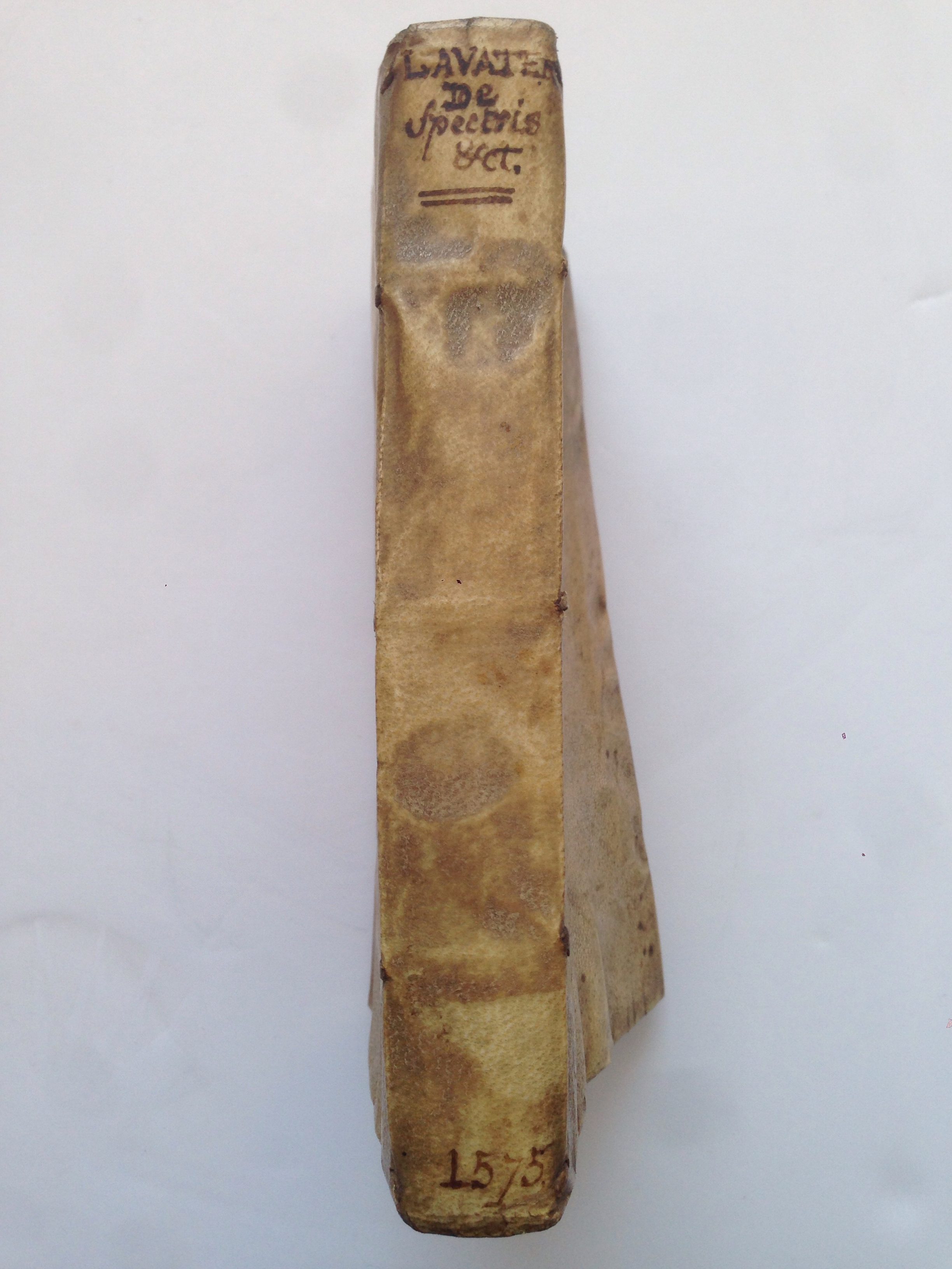LAVATER, Ludwig; DANEAU, Lambert
De spectris, lemu ribus et magnis atque insolitis fragoris, varijsque praesagitionibus quae plerunque obitum hominum..; De veneficis, quos olim sortilegos, nunc autem vulgo sortiarios vocant, dialogus.
[Geneva], Eustache Vignon, 1574£3,850.00
FIRST EDITION of the second work. Two vols. in one. 8vo. 1) pp. [16], 272. 2) pp. 127 [i]. Italic letter, some Roman. Small woodcut printer’s device on both titles, floriated woodcut initials, grotesque woodcut headpieces and ornaments, contemporary shelf mark with price record at head of each vol. “N.123. 30 sols” in first, “N. 127. ?sols” in second, the price rubbed out, C19th engraved armorial book-label of M. A G- du Plessis and P. de la Morandière c. 1900, on pastedown. Light age browning, first title-page a bit spotted, mostly marginal elsewhere. Very good copies in contemporary limp vellum, yapp edges, remains of ties.
Exceptionally rare first edition of this important work on witchcraft by the Protestant Pastor from Geneva, Lambert Daneau, bound with the second latin edition of Lavater’s, (another Protestant), important work on Ghosts, first published in 1569 in German. Daneau’s major work on witchcraft, Dialogus de veneficiis. was translated, in 1575, into English by Thomas Twyne as ‘A Dialogue of Witches.’ “Lambert Daneau, a French Calvanist theologian and Minister, published a treatise on witches in 1574. The book took the form of a dialogue in which one speaker, Theophilus, responded to the occasionally skeptical questions presented to the other speaker, Anthony. The treatise establishes some of the main themes of the late sixteenth and seventeenth-century Protestant demonology. One of the most salient of those features was a heavy reliance on scripture. This biblicism is evident in Daneau’s argument .. that to claim that witches were victims of melancholy was tantamount to the blasphemous denial of the biblical statement that the demoniacs whom Christ cured were also only melancholics and not possessed by demons. A second Protestant theme ..was that the increase in the number of witches was related to the prevalence of superstition and false religion that the Reformation was endeavouring to dispel. ..Calvinists claimed that the age of miracles had ended in biblical times and that magic performed by witches through the power of the devil consisted of nothing more than wonders. Daneau makes this point in his treatiseand he also presents the argument .. that the Devil, despite his great power, could only work within the laws of nature. One of the effects of this line of thought was to make the crime of witchcraft primarily a spiritual offence, consisiting in the pact wth the Devil. This emphasis is clear in Daneau’s treatise, and it was followed by most of the English demonologists of the late sixteenth and seventeenth centuries.” Brian P. Levack . ‘The Witchcraft Sourcebook.’
Lavater (1527-1586) was a prolific author. His work on ghosts, ‘De spectris’ was one of the most frequently printed and widely translated demonological works of the early modern period, going into at least nineteen editions in German, Latin, French, English and Italian. In this treatise on Lemures, ghost shades of the dead which presage great disasters and the change of empires, he maintains that the many of these apparitions are not the souls of the dead but the work of demons. “the ‘De spectris, lemuribus… of the Protestant physician Ludwig Lavater, published in Zurich in 1570, (we) find an impressive and varied picture of supernatural visions. Among the variety of phenomena he discusses, Lavater devotes particular attention to spectral combats, which, he states, are to be understood as bad omens. Such were swords, lances, and a large number of objects seen in the air; clashing armies or fleeing troops seen or heard in the air or the ground; the horrible sound of shouting voices and the clangor of clashing arms.” Ottavia Niccoli. ‘Prophecy and People in Renaissance Italy.’ Lavater does not attack witchcraft directly, but his theory of devils shows he must have believed in the power of sorcery. He also attacked those that used superstition for their own benefit. “Thus for Lavater, men who falsely believed that they saw ghosts, apparitions and visions, were either melancholic, or possessed madmen, or alternatively, just fearful, or weak in their senses, or finally drunkards. Priests and monks on the other hand, in spreading credulous beliefs, were deluding the people for the sake of personal profit and even sexual gratification. .. Lavater substantiated his claim by adducing numerous anecdotes from classical and modern sources (among them Erasmus) in which priests, monks and friars had abused the trust of their flock, appearing as ghosts and spirits of the dead in order to seduce wives, extort money, obtain a bishopric, or prove a theological point by false miracles. ” Michael Heyd. ‘Be Sober and Reasonable’.
An important first edition and most influential work on witchcraft, bound with another seminal work on ghosts.
In stock








